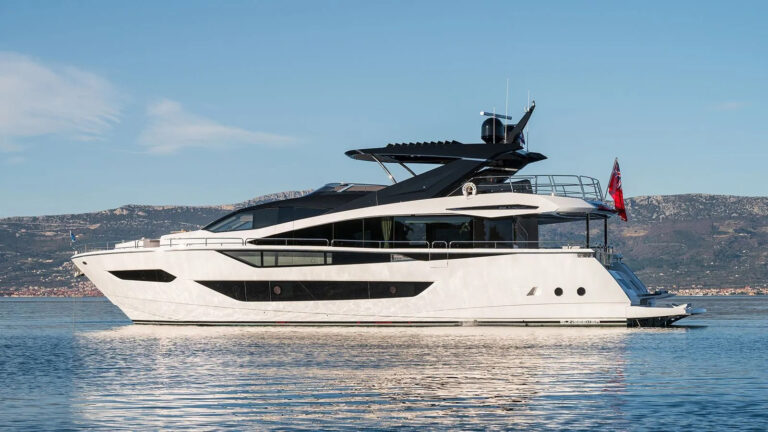Phoenix Marine was established in 1977, when it introduced the popular 29-foot Convertible. Other models followed, and the company earned a reputation for innovation. All would have been peachy if not for a recession and the luxury tax.
Phoenix was forced to close in 1994. Attempts at resurrection continued until Carl Herndon took charge of the company last year, as a subsidiary of Jupiter Marine International Holdings, a publicly traded company that also owns Jupiter Marine. Herndon is as tenacious as the brand he now commands. The founder of Blackfin, Herndon got his start on the production floor at Bertram Yacht in the 1970s and later became its president. He is a survivor in the marine industry, and so are the boats he builds. They are typically conservative in design and construction, carefully finished and targeted specifically at experienced boaters who take fishing and cruising seriously.
This single-mindedness is evident in the new Phoenix 35 Flybridge Convertible, Herndon’s first effort with the nameplate. Make no mistake: This new machine is no regurgitated Phoenix.
Herndon hired naval architect Donald Blount to bring the 35’s hull up to date, adapting it from that of the Phoenix 34 and 33, which were introduced in the 1980s.
“We wanted a bit less running angle than the original design, and we knew moving weight forward was not the answer,” Herndon said.
Keeping weight aft on small convertible designs is tricky, but critical to performance at speed. The solution was to eliminate the keel and fine-tune the propeller pockets and rudders.
“We knew the boat needed more fuel for serious Bahamas cruising, and we needed more weight aft,” Herndon said. “The answer was obvious.” An extra 100 gallons of fuel was added to the single aluminum tank under the cockpit.
My sea trial verified that these efforts paid off. Our test boat had a pair of 420 hp Yanmar 6LY2s, which were impressive in their smooth, relatively smoke-free acceleration. We recorded a top speed of 31.1 knots at 3400 rpm. At 3000 rpm, the 35 cruises easily at a bit more than 24 knots. She has a solid feel and is nimble at trolling speeds. While seas were light during our test, she should deliver a dry, comfortable ride in more challenging conditions. Her moderate entry and 17-degree transom deadrise are suited for a boat of her size and service. A variety of engine choices at similar horsepower ratings are available, and owners should base their choice on personal preference and availability of service. However, I would lean toward the higher horsepower offering in the case of the Cummins.
The 35’s lines are striking. Her silhouette is simple, clean and uncluttered, and does not appear the least bit overstuffed. This is amazing, considering her interior layout is more typical of a 40-footer. In the Blackfin tradition, her deck hardware is beefy and her welded aluminum rails are more than a handful. Air intakes are designed into the deckhouse pilasters and cockpit area, helping to keep the machinery compartment salt-free. A clever air induction system, hidden under the flying bridge overhang, directs fresh air to the helm.
Her 114-square-foot cockpit has a live well molded into the transom coaming and a transom door with a lift gate. A fishbox is plumbed with a macerator, and positive locks secure all deck hatches. Shore cord connections are inside the cockpit (out of the weather), and there is handy rod and gaff stowage under the coaming. Partial cockpit engine boxes abut the bulkhead and serve as seating.
The flying bridge has pedestal helm and companion seating that guests can pass behind without risking evisceration. The helm console has plenty of space for instruments and electronics. Our test boat’s radar, video sounder and plotter fit with room to spare. They neither create a bulky, awkward look nor obstruct the helmsman’s view. There should be no need for an overhead electronics console-or the stiff neck associated with it. Bench seating is forward of the helm.
The 35’s saloon has an L-shape settee to starboard and a raised dinette to port. The settee’s seat back tips up to reveal rod stowage. The seat back can also serve as an upper berth, secured to the overhead with two straps. Dropping the dinette table creates a sleeping spot for two.
Several steps below the saloon is the galley, fitted with a two-burner cooktop, a microwave/convection oven and a dual-voltage refrigerator/freezer. There is also space for an ice maker.
The forward cabin has an island berth with drawers, a lift-top stowage compartment and two cedar-lined hanging lockers. The head has a separate stall shower and seat, and is accessible from the cabin or passageway.
A galley-up, two-stateroom arrangement is available; an impressive option on a relatively small convertible design. The teak interior’s fit and finish are excellent, and a variety of interior décor packages are offered.
The 35 is laid up by hand with a blend of multidirectional stitched fiberglass reinforcement. The bottom is solid, and the hull sides, decks and superstructure are cored with closed cell foam. Stringers are fiberglass-encapsulated wood, and bulkheads and web frames are marine plywood. Molded fiberglass liners define the saloon and belowdecks area. The gelcoat finish is above average.
Surprisingly, while the 35 is fitted with cockpit engine boxes, there is complete engine access from the saloon. A centerline hatch leads to a crawl space where service items, such as the air conditioning and fresh-water system, are easily accessible. I was pleased to find the air-conditioning compressors in the machinery space instead of in package units droning away under the berth and settee. A standard 5.5kW generator with a sound shield is abaft the engines on centerline and accessible from the cockpit. Serious subtropical cruisers may want the optional 7.6kW generator.
The 35 is $369,930 with a pair of 420 hp Yanmar 6LY2s and a solid list of standard equipment, including a generator and air conditioning. Figure on adding about $50,000 to rig her for fishing with a half tower, outriggers and full electronics. Relative to other yachts in the market, this is a good chunk of change for a 35-footer-and one of the reasons several high-quality production builders have strayed from this market. All considered, though, the 35 is a refreshing new player. If you’re a serious fisherman or cruiser, she’s worth serious consideration.
Contact: Phoenix Yacht Corporation, (954) 525-6314; fax (954) 523-9390; www.jupitermarine.com.









